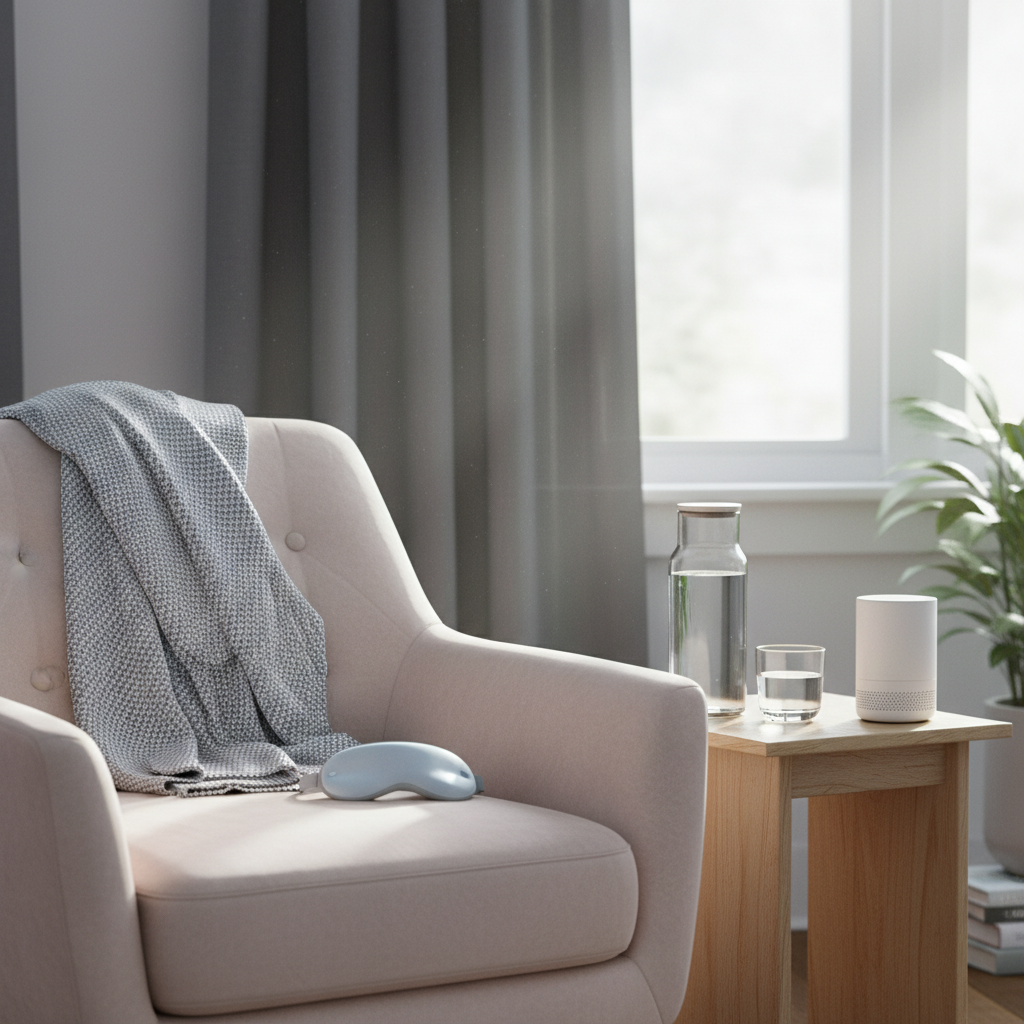
How to Sleep Comfortably in the Second Trimester
The second trimester brings welcome relief from early pregnancy symptoms, but introduces new sleep challenges as your body changes. Finding comfortable sleeping positions becomes increasingly important as your growing bump, hormonal shifts, and physical discomforts can disrupt your rest patterns.
Key Highlights
Here are the most important strategies for better sleep during mid-pregnancy:
- Left side sleeping improves circulation to your baby and reduces pressure on major blood vessels
- Strategic pillow placement between knees, under your bump, and behind your back creates optimal support
- Creating a cool, dark, and quiet sleep environment helps counter pregnancy-related temperature sensitivity
- Establishing a consistent bedtime routine signals to your body it’s time for rest
- Daytime habits like limiting caffeine and timing physical activity affect nighttime sleep quality
Understanding Changes: Why Sleep Changes in Mid-Pregnancy

The second trimester often brings a mix of sleep improvements and new challenges. While many women experience relief from first-trimester nausea and fatigue, your growing abdomen can make finding comfortable positions difficult. Hormonal fluctuations continue to affect sleep cycles, and you might notice increased vivid dreams or middle-of-the-night awakenings. According to the National Sleep Foundation, approximately 78% of pregnant women report more disturbed sleep during pregnancy than before.
Your changing body requires different support during sleep. As your uterus expands, it puts pressure on your bladder, increasing nighttime bathroom trips. You may also experience new physical discomforts like pregnancy headaches second trimester, leg cramps, or back pain that can interrupt sleep. Understanding these normal changes can help you adapt your sleep habits accordingly rather than worrying about temporary sleep difficulties.
Understanding Changes: The Back-Sleeping Dilemma
By mid-pregnancy, back sleeping becomes problematic for most women. When lying flat on your back, your growing uterus puts pressure on the inferior vena cava, the large vein that carries blood from your lower body back to your heart. This can reduce blood flow to your heart and, consequently, to your baby. Many women naturally avoid this position as it becomes uncomfortable, but don’t worry if you occasionally wake up on your back.
The American College of Obstetricians and Gynecologists recommends side-sleeping, particularly on your left side. This position maximizes blood flow to the placenta and improves kidney function by helping your body eliminate waste and reduce swelling. If you’re concerned about accidentally rolling onto your back during sleep, try placing a pillow behind your back as a barrier. This simple adjustment can help maintain a side-sleeping position throughout the night without conscious effort.
Your Body & Baby: The Side-Sleeping Advantage

Sleeping on your left side during the 2nd trimester provides optimal circulation for both you and your baby. This position allows maximum blood flow through the inferior vena cava and the aorta, ensuring efficient delivery of nutrients and oxygen to the placenta. Research published in the Journal of Obstetrics and Gynecology suggests that left-side sleeping may reduce the risk of stillbirth compared to back sleeping, particularly in the third trimester.
Your kidneys also function more efficiently in this position, helping to reduce swelling in your feet, ankles, and hands—a common complaint during pregnancy. While left-side sleeping is ideal, right-side sleeping is still significantly better than back sleeping. If switching between sides helps you stay comfortable, that’s perfectly fine. The goal is to avoid long periods on your back while ensuring you get enough restful sleep for your overall health and well-being. Try to maintain proper hydration without drinking too much before bedtime to minimize nighttime bathroom visits.
Your Body & Baby: Creating Your Perfect Sleep Nest
Strategic pillow placement can transform your sleep experience during pregnancy. Creating a supportive “nest” helps maintain proper spinal alignment and reduces pressure on sensitive areas. Place a pillow between your knees to keep your hips aligned and reduce strain on your lower back and pelvis. Another pillow tucked under your growing bump provides crucial support, preventing the weight of your uterus from pulling on abdominal muscles and ligaments.
Specialized pregnancy pillows come in various shapes, including C-shaped, U-shaped, and wedge designs, each offering unique benefits. The C-shaped pillow supports your back and tucks between your knees, while a U-shaped version provides support on both sides, allowing you to switch positions without rearranging pillows. A simple wedge pillow under your bump can be more space-efficient if you prefer using your regular pillows. While pregnancy pillows can be helpful, regular pillows arranged strategically work just as well for many women. Experiment to find what works best for your body and preferred sleeping position.
Healthy Living Tips: Designing Your Sleep Sanctuary

Your sleep environment significantly impacts sleep quality, especially during pregnancy when your body is more sensitive to temperature and discomfort. Keep your bedroom cool (between 65-70°F or 18-21°C) as hormonal changes often cause pregnant women to feel warmer than usual. Consider using breathable cotton sheets and lightweight blankets that can be easily adjusted if you experience temperature fluctuations during the night.
Darkness stimulates melatonin production, the hormone that regulates sleep, so invest in blackout curtains or an eye mask to block out light. Reduce noise disturbances with earplugs or a white noise machine, which can mask household sounds or partner snoring. If you’re using pregnancy tracking apps, consider enabling night mode features to reduce blue light exposure before bed. Creating a relaxing pre-sleep ritual—like gentle stretching, reading, or a warm bath—signals to your body that it’s time to wind down, making the transition to sleep smoother and more consistent.
Healthy Living Tips: Building Your Pregnancy Sleep Routine
Establishing a consistent sleep schedule helps regulate your body’s internal clock and improves overall sleep quality. Try to go to bed and wake up at similar times each day, even on weekends. During the 2ns trimester, your body needs 7-9 hours of sleep, so plan your schedule accordingly. Consistency reinforces your body’s sleep-wake cycle and can help you fall asleep more easily at night.
Daytime habits significantly impact nighttime sleep quality. Limit caffeine after noon, as it can stay in your system for up to 8 hours. Strategic napping can help combat pregnancy fatigue without disrupting nighttime sleep—aim for short (20-30 minute) naps earlier in the day. Regular physical activity promotes better sleep, but try to complete moderate exercise at least 3-4 hours before bedtime. Relationship changes during pregnancy can also affect your stress levels and sleep quality, so open communication with your partner about sleep needs becomes especially important during this time.
Embracing Better Sleep for You and Baby
Quality sleep during the second trimester isn’t just about comfort—it’s an essential component of prenatal care that benefits both you and your developing baby. By implementing these strategies and creating a sleep routine that works for your changing body, you’ll be better equipped to manage the physical and emotional demands of pregnancy. Remember that sleep needs are highly individual, and finding what works for you may require some experimentation. Be patient with yourself as you adjust to these changes, and don’t hesitate to discuss persistent sleep problems with your healthcare provider.
Sources
National Sleep Foundation – Pregnancy and Sleep
American College of Obstetricians and Gynecologists – Sleep During Pregnancy
Mayo Clinic – Sleep During Pregnancy
Journal of Obstetrics and Gynecology – Maternal Sleep Position and Pregnancy Outcomes
